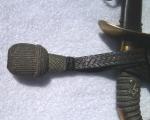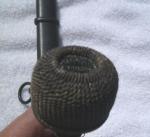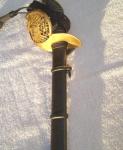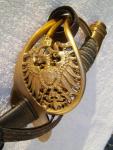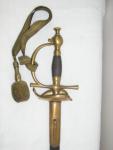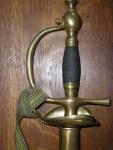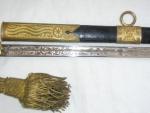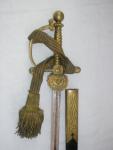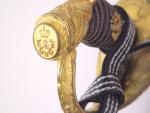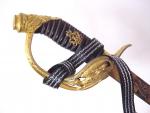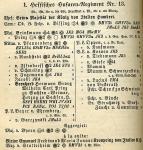-
Posts
43 -
Joined
-
Last visited
Content Type
Profiles
Forums
Blogs
Gallery
Events
Store
Everything posted by Swordguy
-
This one doesn't have a "story"--it's just a remarkably nice Schutztruppen sword. The blade was made in 1890 and used for the new M1891 colonial pattern. The "Grosse" guard is spectacular. Everything else is proofed--indicating a senior NCO issue sword. Of particular note is the sword knot--first I've ever seen on ANY colonial sword. The grip cipher was altered to the Reichs crowned W in 1913. The 2-ring nickled scabbard had a ring removed and then it was de-nickled and blued. This one saw a lot of service!!!!
-
Check the reverse side of the blade for a makers mark. Check the top of the blade for any kind of proof or date mark. The regimental marks are those you mentioned on the hilt. I believe they stand for: Bespannungs-Abteilung der Fuss-Artillerie-Brigade. ie: Teamster Detachment of a Foot Artillery Brigade. The sword was probably a WWI re-issue, where the Army would not want to waste the issue of a new weapon to a third line unit. There is another posibility with the same mark, but it would have been a front line unit with first class weapons. Hope this helps.
-
Something forgotten in my former post. In 1861 Germany mastered the art of producing cast steel. This was a big, big moment for German industrialization. The British had been casting steel for some time. You will find German swords made for the military with the proof marks: (crown)61/W and the exact same mark with the "G" mark above the crown. This stands for "Cast steel". This put the blade smiths out of business. Cheap cast steel vs. expensive hand forged blades. The best smiths had to find a nitch to work in and that was high end damascus steel, while working on horse shoes on the off weeks. Traditionally a German damascus blade has 336 layers of steel and iron producing flexability beyond belief, strength and the ability to hold and edge.
-
This beautiful sword was completed by Ewald Cleff, who worked between 1862 and 1965. Cleff is not known to have produced swords after 1914 when production went over to war material. No swords are known from the WWII period. This maker is known for his distinctive deep etched designs. This style sword was popular in the 1870-80 era predating the patterns ordered for the German military in 1889. It is unknown if Cleff produced blades in his own shop and seems unlikely since he is listed as a blade grinder and finisher. The tang of the blade is usually stamped with the mark of the smith. In this case "KH" possibly Karl Henckels (1849-1917) Karl and his five brothers took over their Fathers sword making business and formed J.A. Henckels in 1870. Their Father was a fine sword maker and displayed at the Crystal Palace in London- 1851. The blade on this sword was "cutting edge" design during the 1870's-80's and beyond. Copied from weapons popular in the British military from about 1850 the "rod back blade" was used in the German mounted troopers swords begining in 1889. In German the rod back blade is called a Steckruckenklinge. A blade of this type can be used to inflict horrid slashing wounds and is strong enough to use as a thrusting weapon as well. While this sword may look very pretty it was built for combat. Little research has been done on sword production in Germany. There were never many damascus blades made and the smiths who could do the work provided blanks to any company who placed an order after which another craftsman would grind the blade, another would polish, another would etch with acid, another would hilt and finally another would add the gilding and lastly assemble and finish. A damascus blade blank from the smith unfinished could add up to 90 gold marks to the cost of a sword and could take the smith up to 40 hours to produce. Even a huge firm like Eickhorn did not have a damascus smith in the factory, they hired all that type of work out because of the cost and the infrequency of orders. Just in passing, when you received a blade blank from a smith you did not know what you were getting. The pattern is reveiled with the acid in one of the final steps of finishing. If you ordered "Band", Turkish, Maidenhair or rose, you had to depend on the smith who himself could only form the pattern in his minds-eye as he worked.
-
Cleaning and restoration To seal a blade after cleaning I use Renaissance Micro-Crystalline wax polish. A 200ml can cost thirty dollars (US) but lasts for quite some time. It is used by the British Museum. ( Picreator Enterprises Ltd. 44 Park View Gardens London NW4 2pn) To help deacidify a leather scabbard I use British Museum "Leather Protector" a buffering agent available from Talas Library Service, NYNY. I use Talas Leather Dressing to finish and polish leather after using the protector. These products are curently the best and most useful in museum conservation.
-
Frosted and etched blades. Never try to restore frosted and etched blades. The frosted part is an acid etch that was left rough to contrast with the higher polished serface after being plated with nickle. Any attempt to "polish" the blade will remove the nickle long before any rust will be removed and the effect will be lost for ever. Soap and water will remove any serface dirt and that is about all you should do. Polishing nickle plate should only be done by a conservation/museum trained expert. A good coat of wax will seal out moisture on a blade. A half pint can of good wax is $30 and worth it. More fine swords have been ruined by the buffing wheel than ever rusted away. Don't buy swords in bad condition to begin with unless you really know what you are doing. Without a formal shop, leave things alone for the most part. I have seen things buffed to ruin and overcleaned to the point that it breaks your heart. I have seen leather scabbards ruined with motor oil, vasiline and "pecards" oil. Cracks and sewing "glued" back together, varnished, you name it. So there you have it.
-

Saxon Cavalry Sabre
Swordguy replied to Rod's topic in Germany: Third Reich: Uniforms, Headwear, Insignia & Equipment
This sword looks to be a version of the model 1892 Saxon Artillerie-Offizierssabel. Page 171 Blankwaffen aus drei jahrunderten Klaus Hilbert. 1998 Brandenburgiches Verlagshaus. -

German Imperial Naval Sword
Swordguy replied to NJB's topic in Germany: Third Reich: Uniforms, Headwear, Insignia & Equipment
Looks like maiden hair damascus steel to me but it has many condition issues that greatly reduces its value. The inscription on the blade makes the sword more interesting because they have now been identified. It is uncommon for Navy swords to have identifications on the blade, that area being reserved for the standard crowned navy anchor and crown and the standard navy ships. The owner's name is normally engraved on the folding guard. I could not identify the mark at the base of the hilt. -
and the point: There is some slight possibility that the "Ribbon" or "Band" pattern blade on this weapon was forged in Bavaria, but it is unlikely. Ribbon Damscus blades were the specialty oi Max Dinger of Solingen. He worked during this period and lived in until 1910. Damascus blades would be ordered from Solingen and delivered finished to sword shops and retailers who took orders, or perhaps hilted the blades. The retailer in this case was Johann Strollberger of Munich.
-
Within the two branches of the princely Bentheim faily, the paterfamilias was distinguished by the title "Furst" his heir as "Erbprinz" and all other males in the family as "Prinz". Prince Alexis's parents were: Ludwig Furst zu Bentheim und Steinfurt (1.8.1812-28. 9. 1890) Married 27. 6. 1839 Bertha Prinzessin zu Hessen-Philipsthal-Barchfeld (26.101818-6.5. 1888) Prince Alexis married in Arolsen, Waldeck 7 MaY 1881 PAULINE PRINZESSIN ZU WALDECK UN PYMONT, BORN 19 OCTOBER 1855 at Aroisen, died 3 July 1925 at Wittgenstein. She was the daughter of reigning Prince Georg Viktor zu Waldeck und Pyrmont (1831-1893) & Helene Prinzessin zu Nassau (1831-1888). Pauline was the sister of Marie Prinzessin zu Waldeck und Pyrmont (1857-1882) who was the first wife of King Wilhelm II of Wurttemberg (1848-1921). This marriage alliance made Prince Alexis the brother in law of the last King of Wurttemberg and the last reigning Prince of Waldeck. Ohter dynastic kinships are less apparent from the information in the 1917 Gothaischer Hofkalender.
-
The Prince of Bentheim-Steinfurt was a holder of: Grand Cosses of the following orders: Prussian Red Eagle, Prussian Crown, Baden Zahringen Lion, Wurttemberg Crown, Wurttemberg Friedrich, British Royal Victorian, Luxembourg Oak Crown, Netherlands Lion, Rumarian Star and Swedish North Star. Commander of the Prussian Johanniter Order, Waldeck Military Merit Cross 1st class, Lippe House Order 1st Class with Swords, Iron Cross 2nd class 1870 on ribbon backing of the Prussian Order of the Crown. No doubt held numerous other royal coronation wedding and jubilee medals and badges which were never listed in the military Rank lists. The 1908 edition of the "German Orders Almanac" entry for him lists a Mecklenburg Wend Crown Order Grand Cross, but that was not listed subsequently, so may have been an entry error.
-
This sword belonged to Alexis Karl Ernst Ludwig Ferdinand Bernhard Furst zu Bentheim und Steinfurt, Graf zu Tecklenburg und Limburg, Herr zu Rheda, Wevelinghoven, Hoya, Alpen, und Helpenstein, Erbvogt von Koln. He was the 4th "Reigning" Prince of Bentheim-Steinfurt. Born as a hereditary member of the Prussian House of Lords (Herrenhaus) 12 October 1854 and to the Wurttemberg Chamber of Lords 11 February 1875, Chapter Commander of the Hannoverian Chapter of the Prussian Johanniter Order (Knights of Saint John). Lifetime part time military "career" a la Suite in Prussian Regiment Garde du Corps Secondelieutenant Premierlieutenant Rittmeister char. Major als 11.11.1884 char. Oberstieuntant alS 27.1.1892 char. Oberst alS 27.1.1895 char. Generalmajor alS 27.1.1899 charakterisiert Generalleutnant a la Suite 11 September 1907 Carried on the rolls of the Prussian Army WWI, but with no actual wartime service (69 in 1914)
-
But there were still some good years ahead. Prince Bernhard transferred over to Hussar Regiment 13. Here he is in 1890 soon after leaving Hussar Regiment 7 wearing his stars and sashes. I know the middle names do not match the order I gave up top, but I am following how they are listed by the Almanach de Gotha. Rick does not have any Prussian Rank List between 1890 and 1902. Can somebody post a late 1890s page with any more awards Prince Bernhard might have had by then? By 1902 it was too late. He was a traitor and a deserter by then a Non Person and all for love. To Be Continued



